RWBI BIO0226: Strategic Direction & Business Issues for the Board
VerifiedAdded on 2023/06/13
|11
|2382
|323
Report
AI Summary
This report examines the importance of strategic direction in business, focusing on entrepreneurship, the SPICE framework, effective decision-making, and social innovation. It highlights how strategic direction helps entrepreneurs with business planning, resource allocation, and cost-effective frameworks. The SPICE framework is presented as a tool for managing talent, performance, and change within a business, aiding in both operational and strategic decision-making. Effective decision-making is discussed in the context of aligning with strategic direction to achieve business objectives, emphasizing the importance of knowledge-based decisions. Social innovation is explored as a means for businesses to meet societal needs and generate social value, with strategic direction playing a crucial role in scaling social innovation initiatives. The report concludes by recommending that boards of directors prioritize strategic planning and integrate skill-based development programs to enhance decision-making and overall business performance. Desklib provides access to similar solved assignments and resources for students.
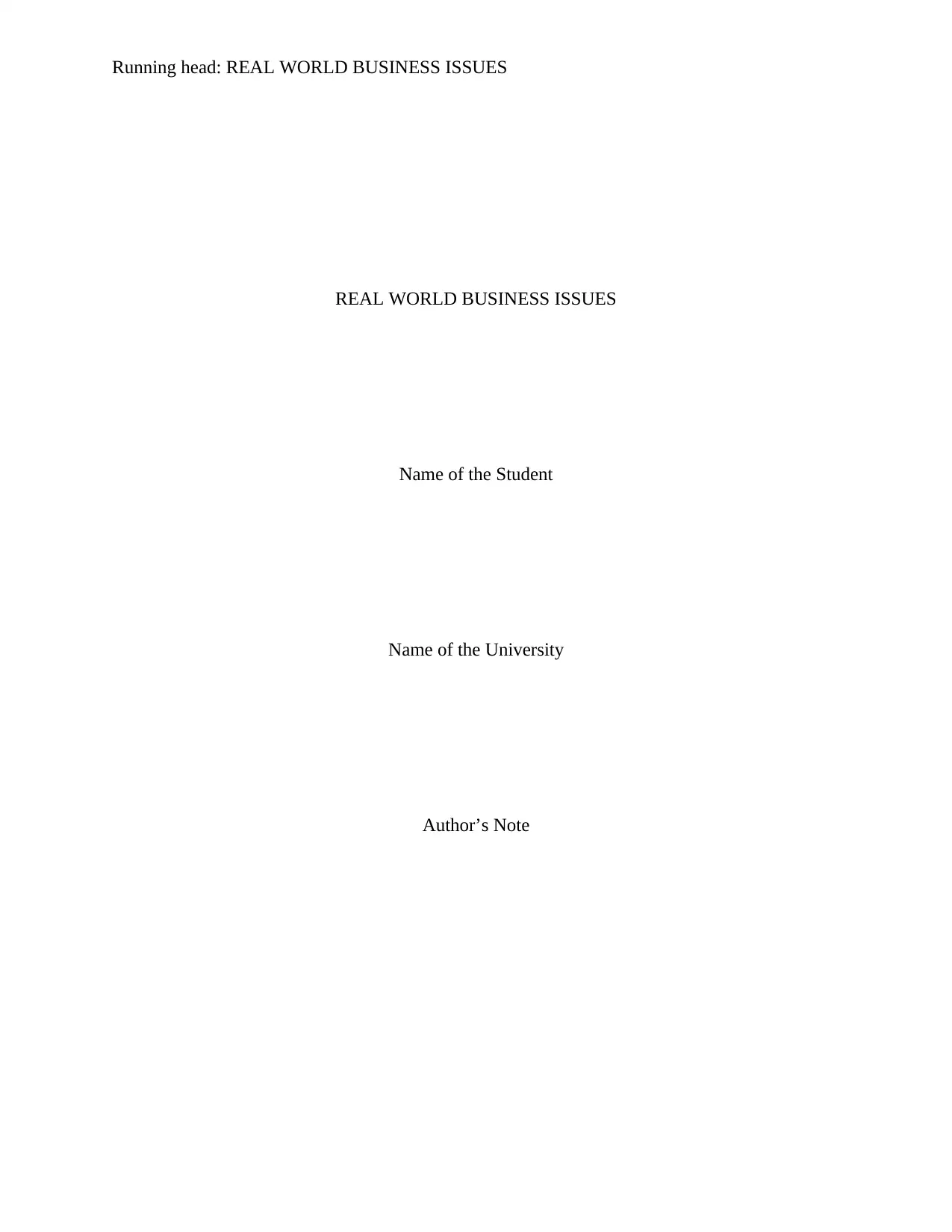
Running head: REAL WORLD BUSINESS ISSUES
REAL WORLD BUSINESS ISSUES
Name of the Student
Name of the University
Author’s Note
REAL WORLD BUSINESS ISSUES
Name of the Student
Name of the University
Author’s Note
Paraphrase This Document
Need a fresh take? Get an instant paraphrase of this document with our AI Paraphraser
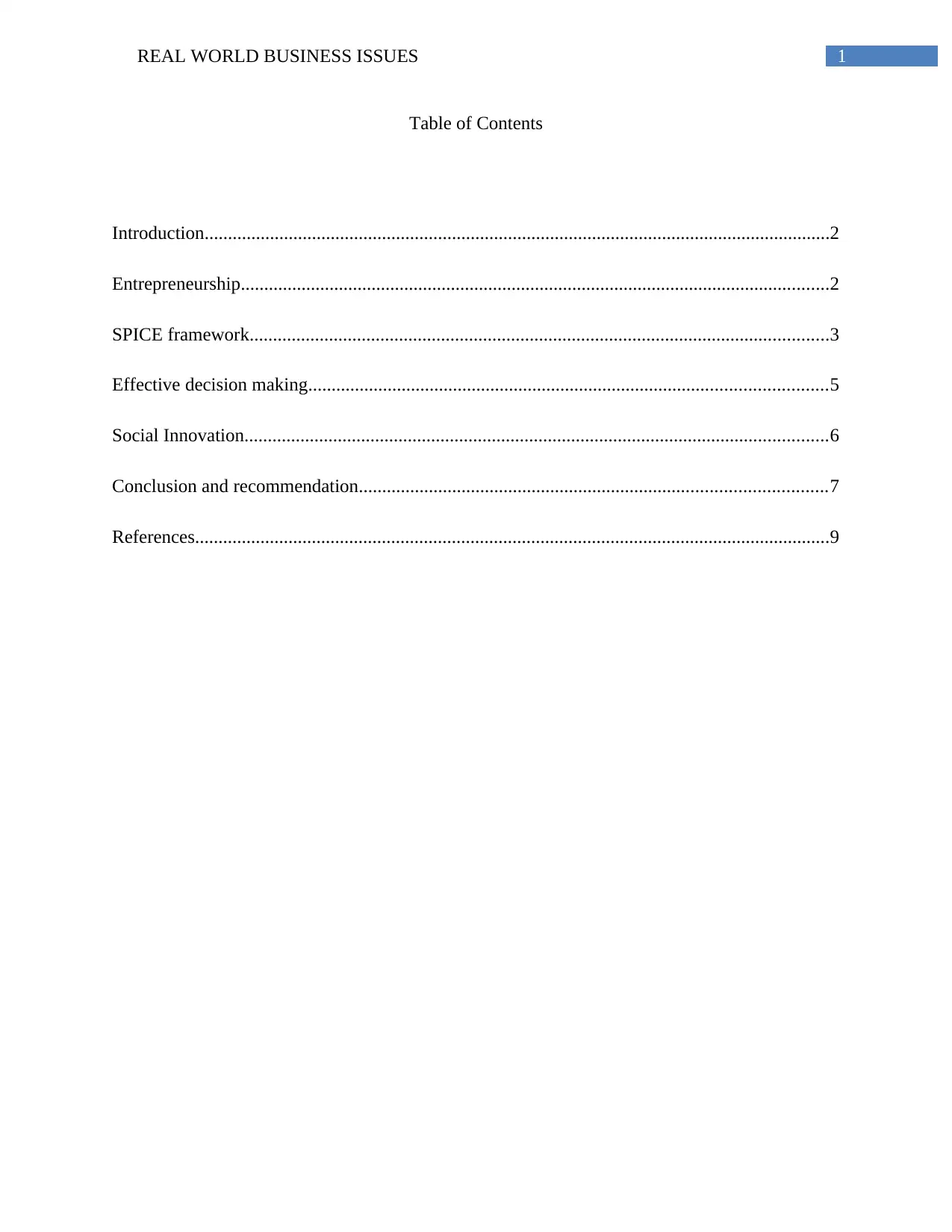
1REAL WORLD BUSINESS ISSUES
Table of Contents
Introduction......................................................................................................................................2
Entrepreneurship..............................................................................................................................2
SPICE framework............................................................................................................................3
Effective decision making...............................................................................................................5
Social Innovation.............................................................................................................................6
Conclusion and recommendation....................................................................................................7
References........................................................................................................................................9
Table of Contents
Introduction......................................................................................................................................2
Entrepreneurship..............................................................................................................................2
SPICE framework............................................................................................................................3
Effective decision making...............................................................................................................5
Social Innovation.............................................................................................................................6
Conclusion and recommendation....................................................................................................7
References........................................................................................................................................9
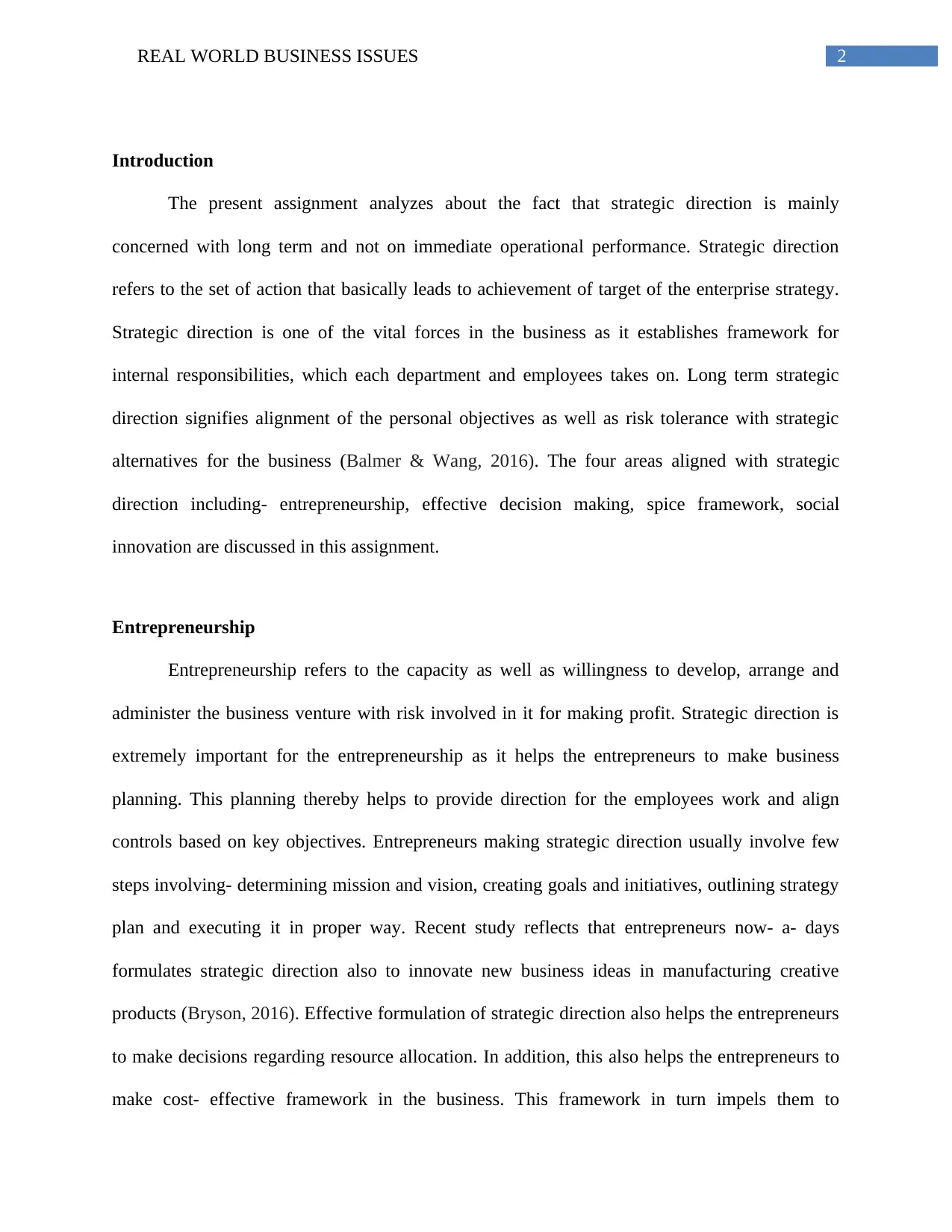
2REAL WORLD BUSINESS ISSUES
Introduction
The present assignment analyzes about the fact that strategic direction is mainly
concerned with long term and not on immediate operational performance. Strategic direction
refers to the set of action that basically leads to achievement of target of the enterprise strategy.
Strategic direction is one of the vital forces in the business as it establishes framework for
internal responsibilities, which each department and employees takes on. Long term strategic
direction signifies alignment of the personal objectives as well as risk tolerance with strategic
alternatives for the business (Balmer & Wang, 2016). The four areas aligned with strategic
direction including- entrepreneurship, effective decision making, spice framework, social
innovation are discussed in this assignment.
Entrepreneurship
Entrepreneurship refers to the capacity as well as willingness to develop, arrange and
administer the business venture with risk involved in it for making profit. Strategic direction is
extremely important for the entrepreneurship as it helps the entrepreneurs to make business
planning. This planning thereby helps to provide direction for the employees work and align
controls based on key objectives. Entrepreneurs making strategic direction usually involve few
steps involving- determining mission and vision, creating goals and initiatives, outlining strategy
plan and executing it in proper way. Recent study reflects that entrepreneurs now- a- days
formulates strategic direction also to innovate new business ideas in manufacturing creative
products (Bryson, 2016). Effective formulation of strategic direction also helps the entrepreneurs
to make decisions regarding resource allocation. In addition, this also helps the entrepreneurs to
make cost- effective framework in the business. This framework in turn impels them to
Introduction
The present assignment analyzes about the fact that strategic direction is mainly
concerned with long term and not on immediate operational performance. Strategic direction
refers to the set of action that basically leads to achievement of target of the enterprise strategy.
Strategic direction is one of the vital forces in the business as it establishes framework for
internal responsibilities, which each department and employees takes on. Long term strategic
direction signifies alignment of the personal objectives as well as risk tolerance with strategic
alternatives for the business (Balmer & Wang, 2016). The four areas aligned with strategic
direction including- entrepreneurship, effective decision making, spice framework, social
innovation are discussed in this assignment.
Entrepreneurship
Entrepreneurship refers to the capacity as well as willingness to develop, arrange and
administer the business venture with risk involved in it for making profit. Strategic direction is
extremely important for the entrepreneurship as it helps the entrepreneurs to make business
planning. This planning thereby helps to provide direction for the employees work and align
controls based on key objectives. Entrepreneurs making strategic direction usually involve few
steps involving- determining mission and vision, creating goals and initiatives, outlining strategy
plan and executing it in proper way. Recent study reflects that entrepreneurs now- a- days
formulates strategic direction also to innovate new business ideas in manufacturing creative
products (Bryson, 2016). Effective formulation of strategic direction also helps the entrepreneurs
to make decisions regarding resource allocation. In addition, this also helps the entrepreneurs to
make cost- effective framework in the business. This framework in turn impels them to
⊘ This is a preview!⊘
Do you want full access?
Subscribe today to unlock all pages.

Trusted by 1+ million students worldwide
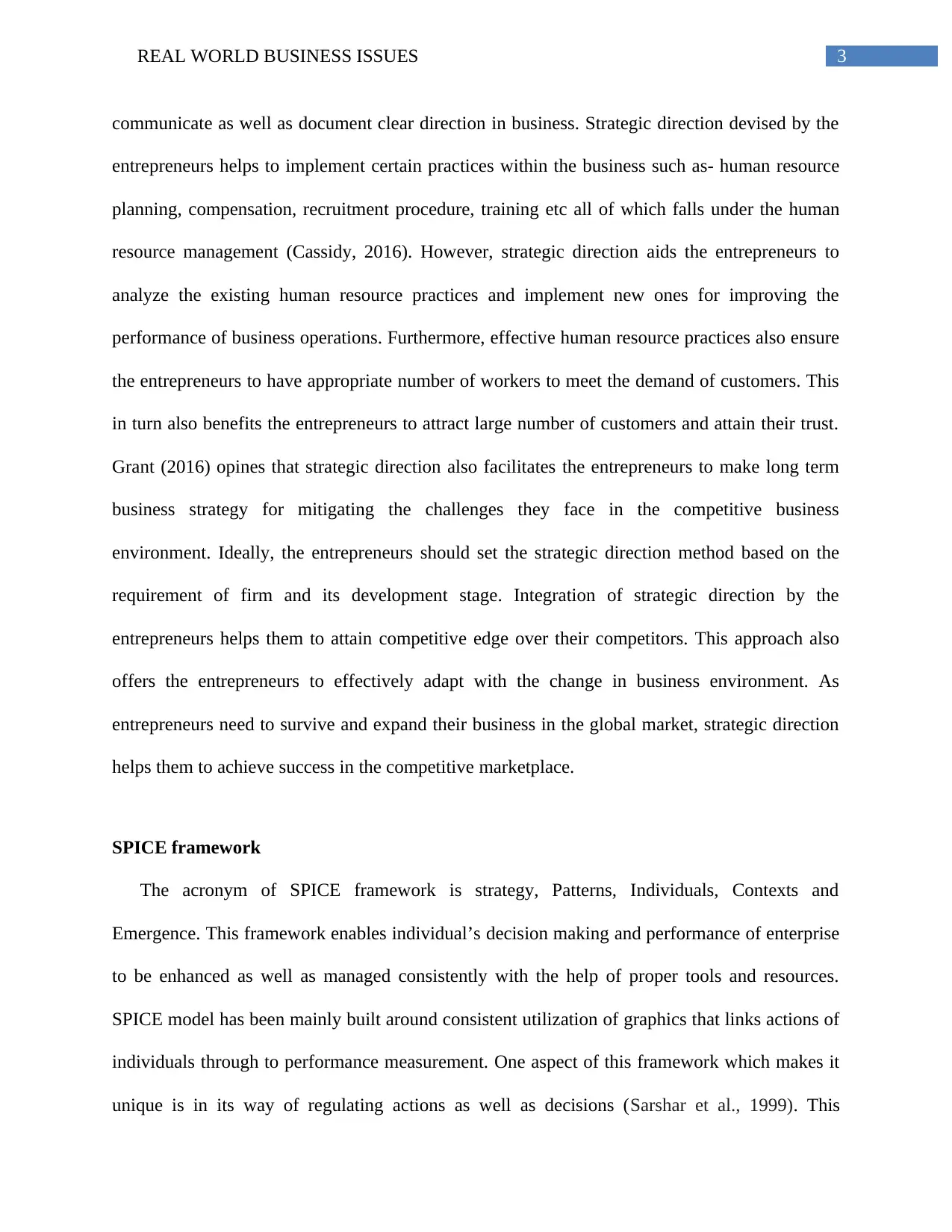
3REAL WORLD BUSINESS ISSUES
communicate as well as document clear direction in business. Strategic direction devised by the
entrepreneurs helps to implement certain practices within the business such as- human resource
planning, compensation, recruitment procedure, training etc all of which falls under the human
resource management (Cassidy, 2016). However, strategic direction aids the entrepreneurs to
analyze the existing human resource practices and implement new ones for improving the
performance of business operations. Furthermore, effective human resource practices also ensure
the entrepreneurs to have appropriate number of workers to meet the demand of customers. This
in turn also benefits the entrepreneurs to attract large number of customers and attain their trust.
Grant (2016) opines that strategic direction also facilitates the entrepreneurs to make long term
business strategy for mitigating the challenges they face in the competitive business
environment. Ideally, the entrepreneurs should set the strategic direction method based on the
requirement of firm and its development stage. Integration of strategic direction by the
entrepreneurs helps them to attain competitive edge over their competitors. This approach also
offers the entrepreneurs to effectively adapt with the change in business environment. As
entrepreneurs need to survive and expand their business in the global market, strategic direction
helps them to achieve success in the competitive marketplace.
SPICE framework
The acronym of SPICE framework is strategy, Patterns, Individuals, Contexts and
Emergence. This framework enables individual’s decision making and performance of enterprise
to be enhanced as well as managed consistently with the help of proper tools and resources.
SPICE model has been mainly built around consistent utilization of graphics that links actions of
individuals through to performance measurement. One aspect of this framework which makes it
unique is in its way of regulating actions as well as decisions (Sarshar et al., 1999). This
communicate as well as document clear direction in business. Strategic direction devised by the
entrepreneurs helps to implement certain practices within the business such as- human resource
planning, compensation, recruitment procedure, training etc all of which falls under the human
resource management (Cassidy, 2016). However, strategic direction aids the entrepreneurs to
analyze the existing human resource practices and implement new ones for improving the
performance of business operations. Furthermore, effective human resource practices also ensure
the entrepreneurs to have appropriate number of workers to meet the demand of customers. This
in turn also benefits the entrepreneurs to attract large number of customers and attain their trust.
Grant (2016) opines that strategic direction also facilitates the entrepreneurs to make long term
business strategy for mitigating the challenges they face in the competitive business
environment. Ideally, the entrepreneurs should set the strategic direction method based on the
requirement of firm and its development stage. Integration of strategic direction by the
entrepreneurs helps them to attain competitive edge over their competitors. This approach also
offers the entrepreneurs to effectively adapt with the change in business environment. As
entrepreneurs need to survive and expand their business in the global market, strategic direction
helps them to achieve success in the competitive marketplace.
SPICE framework
The acronym of SPICE framework is strategy, Patterns, Individuals, Contexts and
Emergence. This framework enables individual’s decision making and performance of enterprise
to be enhanced as well as managed consistently with the help of proper tools and resources.
SPICE model has been mainly built around consistent utilization of graphics that links actions of
individuals through to performance measurement. One aspect of this framework which makes it
unique is in its way of regulating actions as well as decisions (Sarshar et al., 1999). This
Paraphrase This Document
Need a fresh take? Get an instant paraphrase of this document with our AI Paraphraser
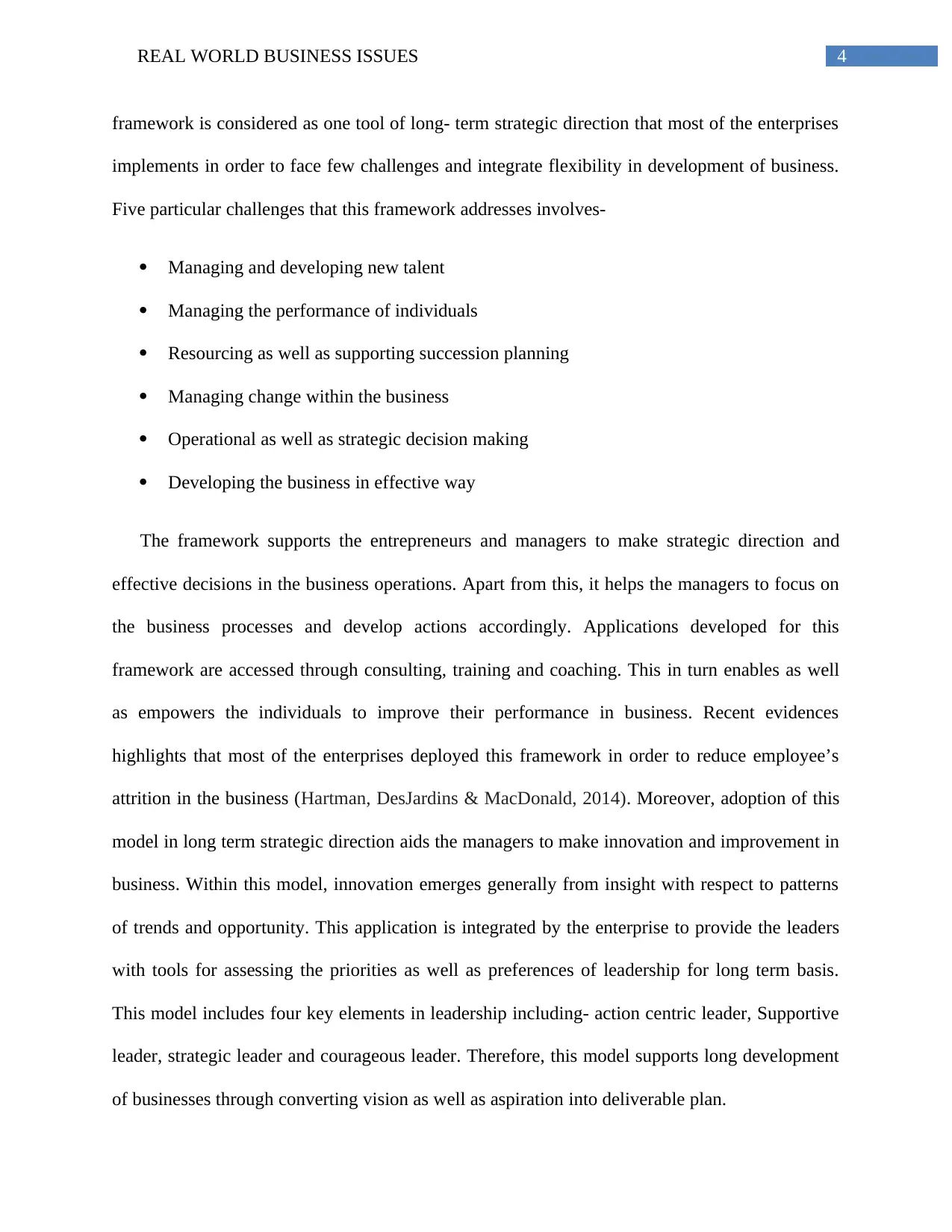
4REAL WORLD BUSINESS ISSUES
framework is considered as one tool of long- term strategic direction that most of the enterprises
implements in order to face few challenges and integrate flexibility in development of business.
Five particular challenges that this framework addresses involves-
Managing and developing new talent
Managing the performance of individuals
Resourcing as well as supporting succession planning
Managing change within the business
Operational as well as strategic decision making
Developing the business in effective way
The framework supports the entrepreneurs and managers to make strategic direction and
effective decisions in the business operations. Apart from this, it helps the managers to focus on
the business processes and develop actions accordingly. Applications developed for this
framework are accessed through consulting, training and coaching. This in turn enables as well
as empowers the individuals to improve their performance in business. Recent evidences
highlights that most of the enterprises deployed this framework in order to reduce employee’s
attrition in the business (Hartman, DesJardins & MacDonald, 2014). Moreover, adoption of this
model in long term strategic direction aids the managers to make innovation and improvement in
business. Within this model, innovation emerges generally from insight with respect to patterns
of trends and opportunity. This application is integrated by the enterprise to provide the leaders
with tools for assessing the priorities as well as preferences of leadership for long term basis.
This model includes four key elements in leadership including- action centric leader, Supportive
leader, strategic leader and courageous leader. Therefore, this model supports long development
of businesses through converting vision as well as aspiration into deliverable plan.
framework is considered as one tool of long- term strategic direction that most of the enterprises
implements in order to face few challenges and integrate flexibility in development of business.
Five particular challenges that this framework addresses involves-
Managing and developing new talent
Managing the performance of individuals
Resourcing as well as supporting succession planning
Managing change within the business
Operational as well as strategic decision making
Developing the business in effective way
The framework supports the entrepreneurs and managers to make strategic direction and
effective decisions in the business operations. Apart from this, it helps the managers to focus on
the business processes and develop actions accordingly. Applications developed for this
framework are accessed through consulting, training and coaching. This in turn enables as well
as empowers the individuals to improve their performance in business. Recent evidences
highlights that most of the enterprises deployed this framework in order to reduce employee’s
attrition in the business (Hartman, DesJardins & MacDonald, 2014). Moreover, adoption of this
model in long term strategic direction aids the managers to make innovation and improvement in
business. Within this model, innovation emerges generally from insight with respect to patterns
of trends and opportunity. This application is integrated by the enterprise to provide the leaders
with tools for assessing the priorities as well as preferences of leadership for long term basis.
This model includes four key elements in leadership including- action centric leader, Supportive
leader, strategic leader and courageous leader. Therefore, this model supports long development
of businesses through converting vision as well as aspiration into deliverable plan.
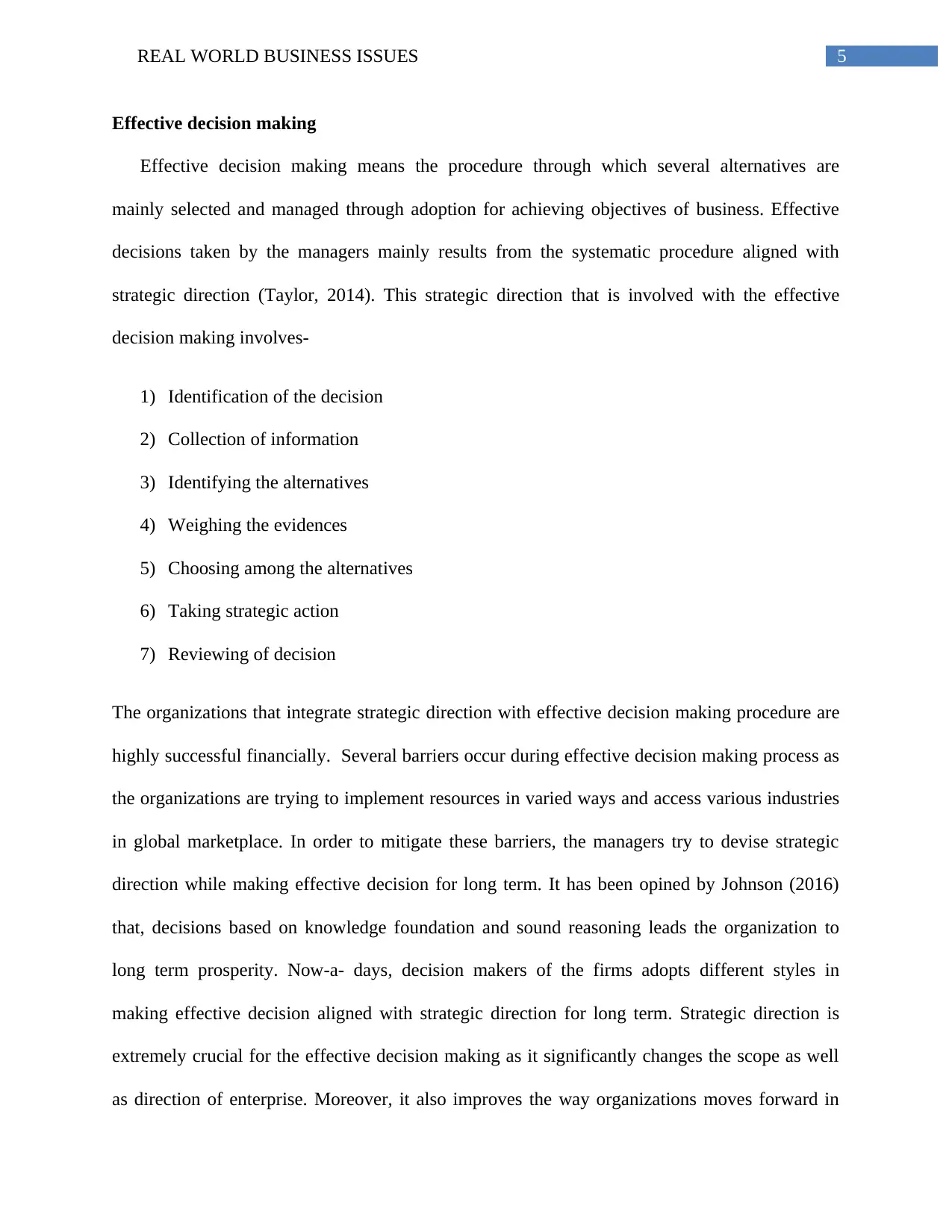
5REAL WORLD BUSINESS ISSUES
Effective decision making
Effective decision making means the procedure through which several alternatives are
mainly selected and managed through adoption for achieving objectives of business. Effective
decisions taken by the managers mainly results from the systematic procedure aligned with
strategic direction (Taylor, 2014). This strategic direction that is involved with the effective
decision making involves-
1) Identification of the decision
2) Collection of information
3) Identifying the alternatives
4) Weighing the evidences
5) Choosing among the alternatives
6) Taking strategic action
7) Reviewing of decision
The organizations that integrate strategic direction with effective decision making procedure are
highly successful financially. Several barriers occur during effective decision making process as
the organizations are trying to implement resources in varied ways and access various industries
in global marketplace. In order to mitigate these barriers, the managers try to devise strategic
direction while making effective decision for long term. It has been opined by Johnson (2016)
that, decisions based on knowledge foundation and sound reasoning leads the organization to
long term prosperity. Now-a- days, decision makers of the firms adopts different styles in
making effective decision aligned with strategic direction for long term. Strategic direction is
extremely crucial for the effective decision making as it significantly changes the scope as well
as direction of enterprise. Moreover, it also improves the way organizations moves forward in
Effective decision making
Effective decision making means the procedure through which several alternatives are
mainly selected and managed through adoption for achieving objectives of business. Effective
decisions taken by the managers mainly results from the systematic procedure aligned with
strategic direction (Taylor, 2014). This strategic direction that is involved with the effective
decision making involves-
1) Identification of the decision
2) Collection of information
3) Identifying the alternatives
4) Weighing the evidences
5) Choosing among the alternatives
6) Taking strategic action
7) Reviewing of decision
The organizations that integrate strategic direction with effective decision making procedure are
highly successful financially. Several barriers occur during effective decision making process as
the organizations are trying to implement resources in varied ways and access various industries
in global marketplace. In order to mitigate these barriers, the managers try to devise strategic
direction while making effective decision for long term. It has been opined by Johnson (2016)
that, decisions based on knowledge foundation and sound reasoning leads the organization to
long term prosperity. Now-a- days, decision makers of the firms adopts different styles in
making effective decision aligned with strategic direction for long term. Strategic direction is
extremely crucial for the effective decision making as it significantly changes the scope as well
as direction of enterprise. Moreover, it also improves the way organizations moves forward in
⊘ This is a preview!⊘
Do you want full access?
Subscribe today to unlock all pages.

Trusted by 1+ million students worldwide
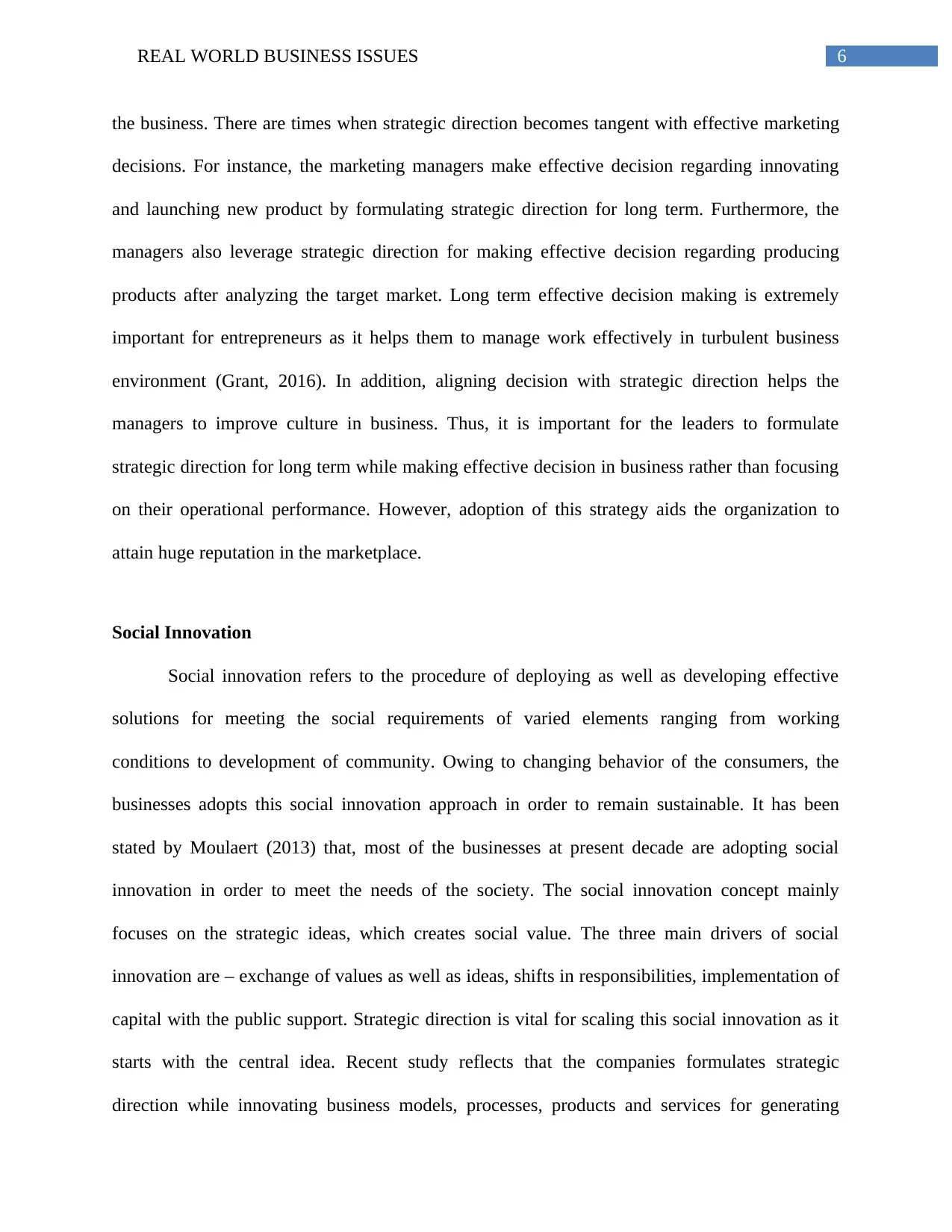
6REAL WORLD BUSINESS ISSUES
the business. There are times when strategic direction becomes tangent with effective marketing
decisions. For instance, the marketing managers make effective decision regarding innovating
and launching new product by formulating strategic direction for long term. Furthermore, the
managers also leverage strategic direction for making effective decision regarding producing
products after analyzing the target market. Long term effective decision making is extremely
important for entrepreneurs as it helps them to manage work effectively in turbulent business
environment (Grant, 2016). In addition, aligning decision with strategic direction helps the
managers to improve culture in business. Thus, it is important for the leaders to formulate
strategic direction for long term while making effective decision in business rather than focusing
on their operational performance. However, adoption of this strategy aids the organization to
attain huge reputation in the marketplace.
Social Innovation
Social innovation refers to the procedure of deploying as well as developing effective
solutions for meeting the social requirements of varied elements ranging from working
conditions to development of community. Owing to changing behavior of the consumers, the
businesses adopts this social innovation approach in order to remain sustainable. It has been
stated by Moulaert (2013) that, most of the businesses at present decade are adopting social
innovation in order to meet the needs of the society. The social innovation concept mainly
focuses on the strategic ideas, which creates social value. The three main drivers of social
innovation are – exchange of values as well as ideas, shifts in responsibilities, implementation of
capital with the public support. Strategic direction is vital for scaling this social innovation as it
starts with the central idea. Recent study reflects that the companies formulates strategic
direction while innovating business models, processes, products and services for generating
the business. There are times when strategic direction becomes tangent with effective marketing
decisions. For instance, the marketing managers make effective decision regarding innovating
and launching new product by formulating strategic direction for long term. Furthermore, the
managers also leverage strategic direction for making effective decision regarding producing
products after analyzing the target market. Long term effective decision making is extremely
important for entrepreneurs as it helps them to manage work effectively in turbulent business
environment (Grant, 2016). In addition, aligning decision with strategic direction helps the
managers to improve culture in business. Thus, it is important for the leaders to formulate
strategic direction for long term while making effective decision in business rather than focusing
on their operational performance. However, adoption of this strategy aids the organization to
attain huge reputation in the marketplace.
Social Innovation
Social innovation refers to the procedure of deploying as well as developing effective
solutions for meeting the social requirements of varied elements ranging from working
conditions to development of community. Owing to changing behavior of the consumers, the
businesses adopts this social innovation approach in order to remain sustainable. It has been
stated by Moulaert (2013) that, most of the businesses at present decade are adopting social
innovation in order to meet the needs of the society. The social innovation concept mainly
focuses on the strategic ideas, which creates social value. The three main drivers of social
innovation are – exchange of values as well as ideas, shifts in responsibilities, implementation of
capital with the public support. Strategic direction is vital for scaling this social innovation as it
starts with the central idea. Recent study reflects that the companies formulates strategic
direction while innovating business models, processes, products and services for generating
Paraphrase This Document
Need a fresh take? Get an instant paraphrase of this document with our AI Paraphraser
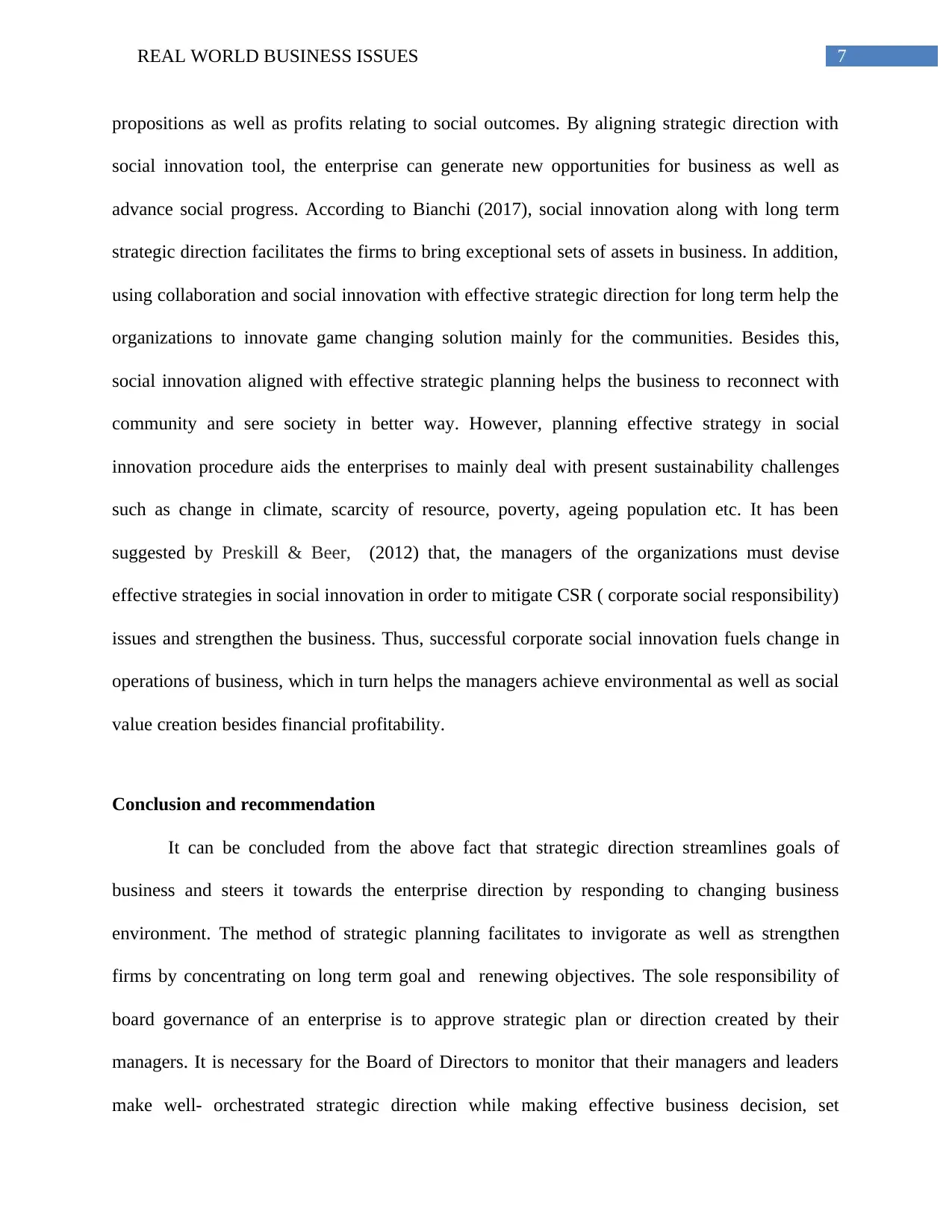
7REAL WORLD BUSINESS ISSUES
propositions as well as profits relating to social outcomes. By aligning strategic direction with
social innovation tool, the enterprise can generate new opportunities for business as well as
advance social progress. According to Bianchi (2017), social innovation along with long term
strategic direction facilitates the firms to bring exceptional sets of assets in business. In addition,
using collaboration and social innovation with effective strategic direction for long term help the
organizations to innovate game changing solution mainly for the communities. Besides this,
social innovation aligned with effective strategic planning helps the business to reconnect with
community and sere society in better way. However, planning effective strategy in social
innovation procedure aids the enterprises to mainly deal with present sustainability challenges
such as change in climate, scarcity of resource, poverty, ageing population etc. It has been
suggested by Preskill & Beer, (2012) that, the managers of the organizations must devise
effective strategies in social innovation in order to mitigate CSR ( corporate social responsibility)
issues and strengthen the business. Thus, successful corporate social innovation fuels change in
operations of business, which in turn helps the managers achieve environmental as well as social
value creation besides financial profitability.
Conclusion and recommendation
It can be concluded from the above fact that strategic direction streamlines goals of
business and steers it towards the enterprise direction by responding to changing business
environment. The method of strategic planning facilitates to invigorate as well as strengthen
firms by concentrating on long term goal and renewing objectives. The sole responsibility of
board governance of an enterprise is to approve strategic plan or direction created by their
managers. It is necessary for the Board of Directors to monitor that their managers and leaders
make well- orchestrated strategic direction while making effective business decision, set
propositions as well as profits relating to social outcomes. By aligning strategic direction with
social innovation tool, the enterprise can generate new opportunities for business as well as
advance social progress. According to Bianchi (2017), social innovation along with long term
strategic direction facilitates the firms to bring exceptional sets of assets in business. In addition,
using collaboration and social innovation with effective strategic direction for long term help the
organizations to innovate game changing solution mainly for the communities. Besides this,
social innovation aligned with effective strategic planning helps the business to reconnect with
community and sere society in better way. However, planning effective strategy in social
innovation procedure aids the enterprises to mainly deal with present sustainability challenges
such as change in climate, scarcity of resource, poverty, ageing population etc. It has been
suggested by Preskill & Beer, (2012) that, the managers of the organizations must devise
effective strategies in social innovation in order to mitigate CSR ( corporate social responsibility)
issues and strengthen the business. Thus, successful corporate social innovation fuels change in
operations of business, which in turn helps the managers achieve environmental as well as social
value creation besides financial profitability.
Conclusion and recommendation
It can be concluded from the above fact that strategic direction streamlines goals of
business and steers it towards the enterprise direction by responding to changing business
environment. The method of strategic planning facilitates to invigorate as well as strengthen
firms by concentrating on long term goal and renewing objectives. The sole responsibility of
board governance of an enterprise is to approve strategic plan or direction created by their
managers. It is necessary for the Board of Directors to monitor that their managers and leaders
make well- orchestrated strategic direction while making effective business decision, set
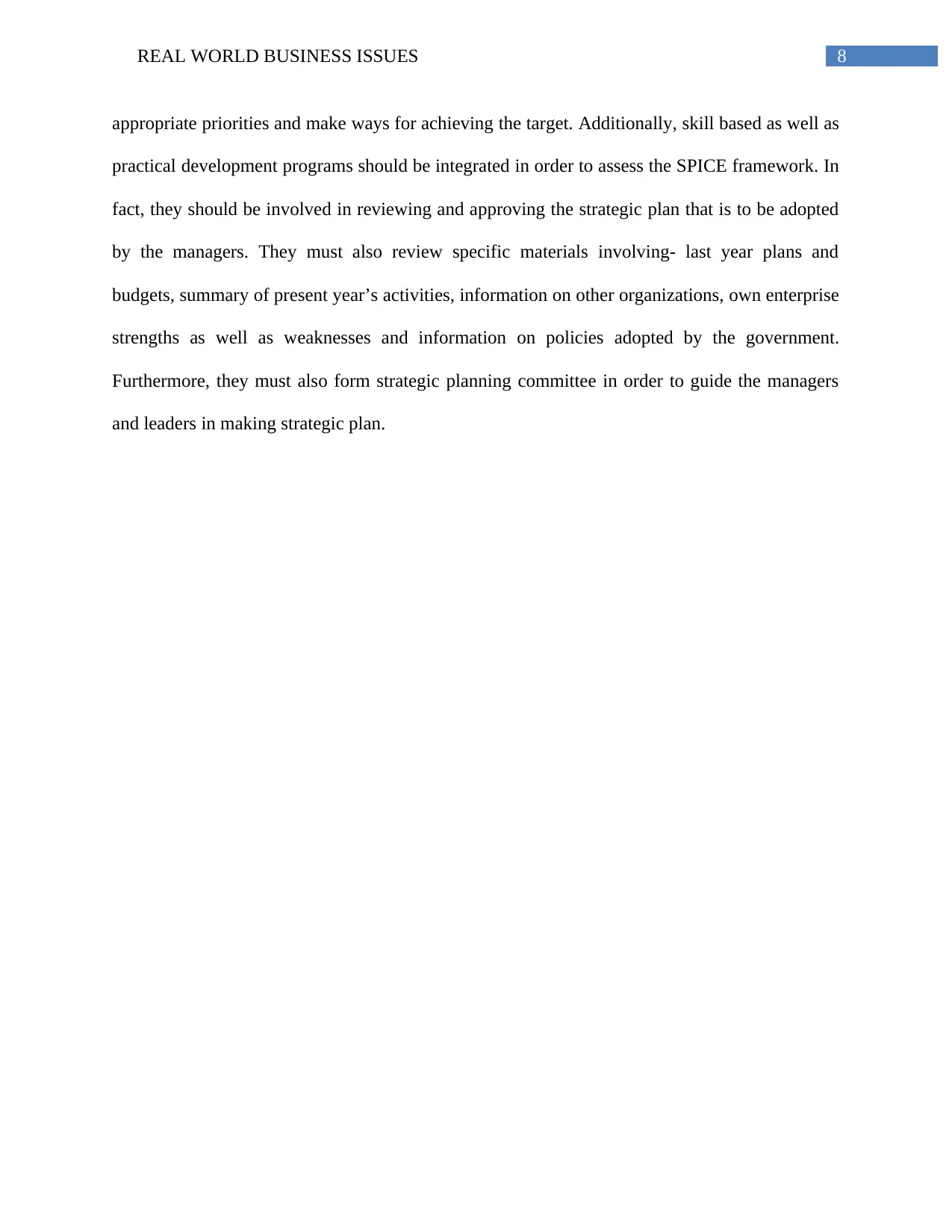
8REAL WORLD BUSINESS ISSUES
appropriate priorities and make ways for achieving the target. Additionally, skill based as well as
practical development programs should be integrated in order to assess the SPICE framework. In
fact, they should be involved in reviewing and approving the strategic plan that is to be adopted
by the managers. They must also review specific materials involving- last year plans and
budgets, summary of present year’s activities, information on other organizations, own enterprise
strengths as well as weaknesses and information on policies adopted by the government.
Furthermore, they must also form strategic planning committee in order to guide the managers
and leaders in making strategic plan.
appropriate priorities and make ways for achieving the target. Additionally, skill based as well as
practical development programs should be integrated in order to assess the SPICE framework. In
fact, they should be involved in reviewing and approving the strategic plan that is to be adopted
by the managers. They must also review specific materials involving- last year plans and
budgets, summary of present year’s activities, information on other organizations, own enterprise
strengths as well as weaknesses and information on policies adopted by the government.
Furthermore, they must also form strategic planning committee in order to guide the managers
and leaders in making strategic plan.
⊘ This is a preview!⊘
Do you want full access?
Subscribe today to unlock all pages.

Trusted by 1+ million students worldwide
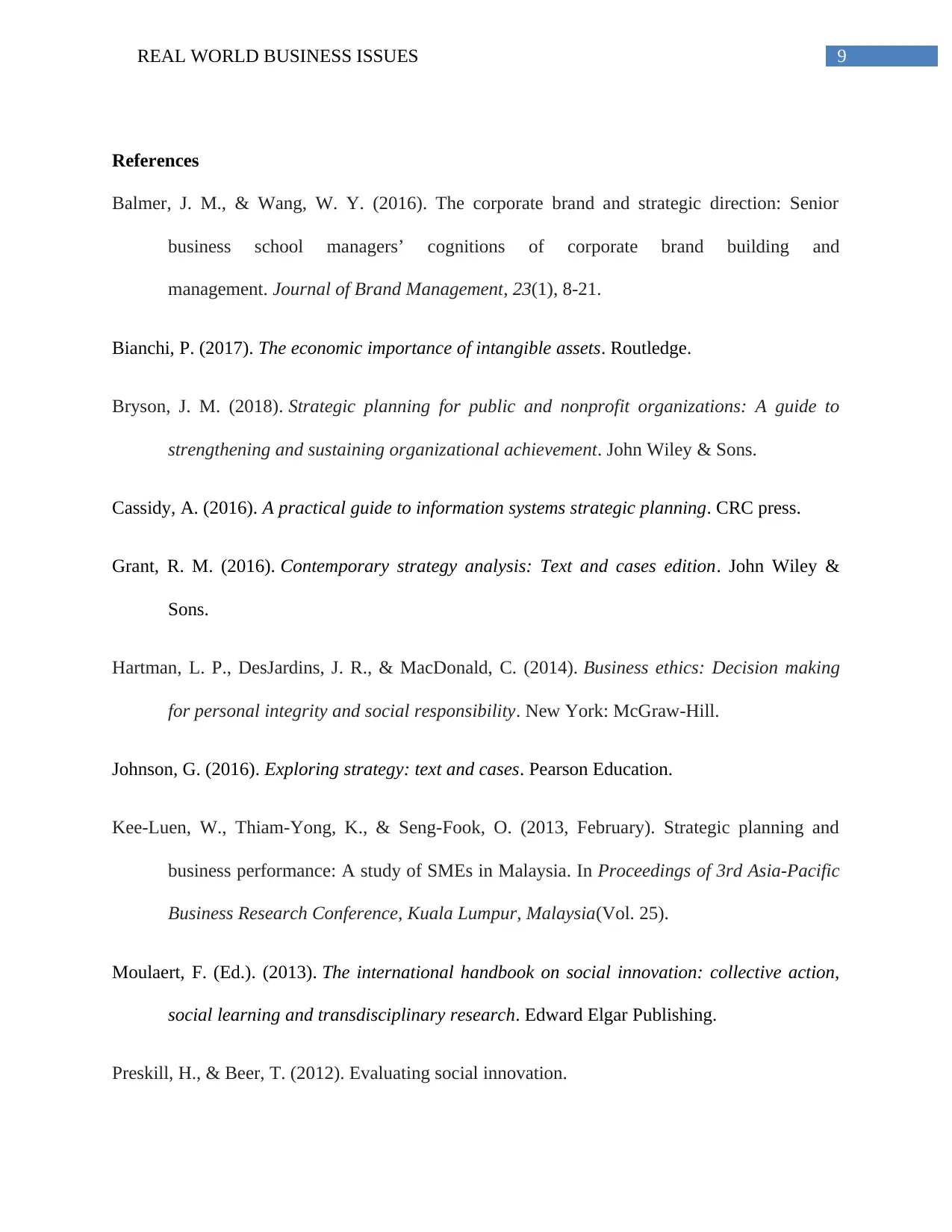
9REAL WORLD BUSINESS ISSUES
References
Balmer, J. M., & Wang, W. Y. (2016). The corporate brand and strategic direction: Senior
business school managers’ cognitions of corporate brand building and
management. Journal of Brand Management, 23(1), 8-21.
Bianchi, P. (2017). The economic importance of intangible assets. Routledge.
Bryson, J. M. (2018). Strategic planning for public and nonprofit organizations: A guide to
strengthening and sustaining organizational achievement. John Wiley & Sons.
Cassidy, A. (2016). A practical guide to information systems strategic planning. CRC press.
Grant, R. M. (2016). Contemporary strategy analysis: Text and cases edition. John Wiley &
Sons.
Hartman, L. P., DesJardins, J. R., & MacDonald, C. (2014). Business ethics: Decision making
for personal integrity and social responsibility. New York: McGraw-Hill.
Johnson, G. (2016). Exploring strategy: text and cases. Pearson Education.
Kee-Luen, W., Thiam-Yong, K., & Seng-Fook, O. (2013, February). Strategic planning and
business performance: A study of SMEs in Malaysia. In Proceedings of 3rd Asia-Pacific
Business Research Conference, Kuala Lumpur, Malaysia(Vol. 25).
Moulaert, F. (Ed.). (2013). The international handbook on social innovation: collective action,
social learning and transdisciplinary research. Edward Elgar Publishing.
Preskill, H., & Beer, T. (2012). Evaluating social innovation.
References
Balmer, J. M., & Wang, W. Y. (2016). The corporate brand and strategic direction: Senior
business school managers’ cognitions of corporate brand building and
management. Journal of Brand Management, 23(1), 8-21.
Bianchi, P. (2017). The economic importance of intangible assets. Routledge.
Bryson, J. M. (2018). Strategic planning for public and nonprofit organizations: A guide to
strengthening and sustaining organizational achievement. John Wiley & Sons.
Cassidy, A. (2016). A practical guide to information systems strategic planning. CRC press.
Grant, R. M. (2016). Contemporary strategy analysis: Text and cases edition. John Wiley &
Sons.
Hartman, L. P., DesJardins, J. R., & MacDonald, C. (2014). Business ethics: Decision making
for personal integrity and social responsibility. New York: McGraw-Hill.
Johnson, G. (2016). Exploring strategy: text and cases. Pearson Education.
Kee-Luen, W., Thiam-Yong, K., & Seng-Fook, O. (2013, February). Strategic planning and
business performance: A study of SMEs in Malaysia. In Proceedings of 3rd Asia-Pacific
Business Research Conference, Kuala Lumpur, Malaysia(Vol. 25).
Moulaert, F. (Ed.). (2013). The international handbook on social innovation: collective action,
social learning and transdisciplinary research. Edward Elgar Publishing.
Preskill, H., & Beer, T. (2012). Evaluating social innovation.
Paraphrase This Document
Need a fresh take? Get an instant paraphrase of this document with our AI Paraphraser
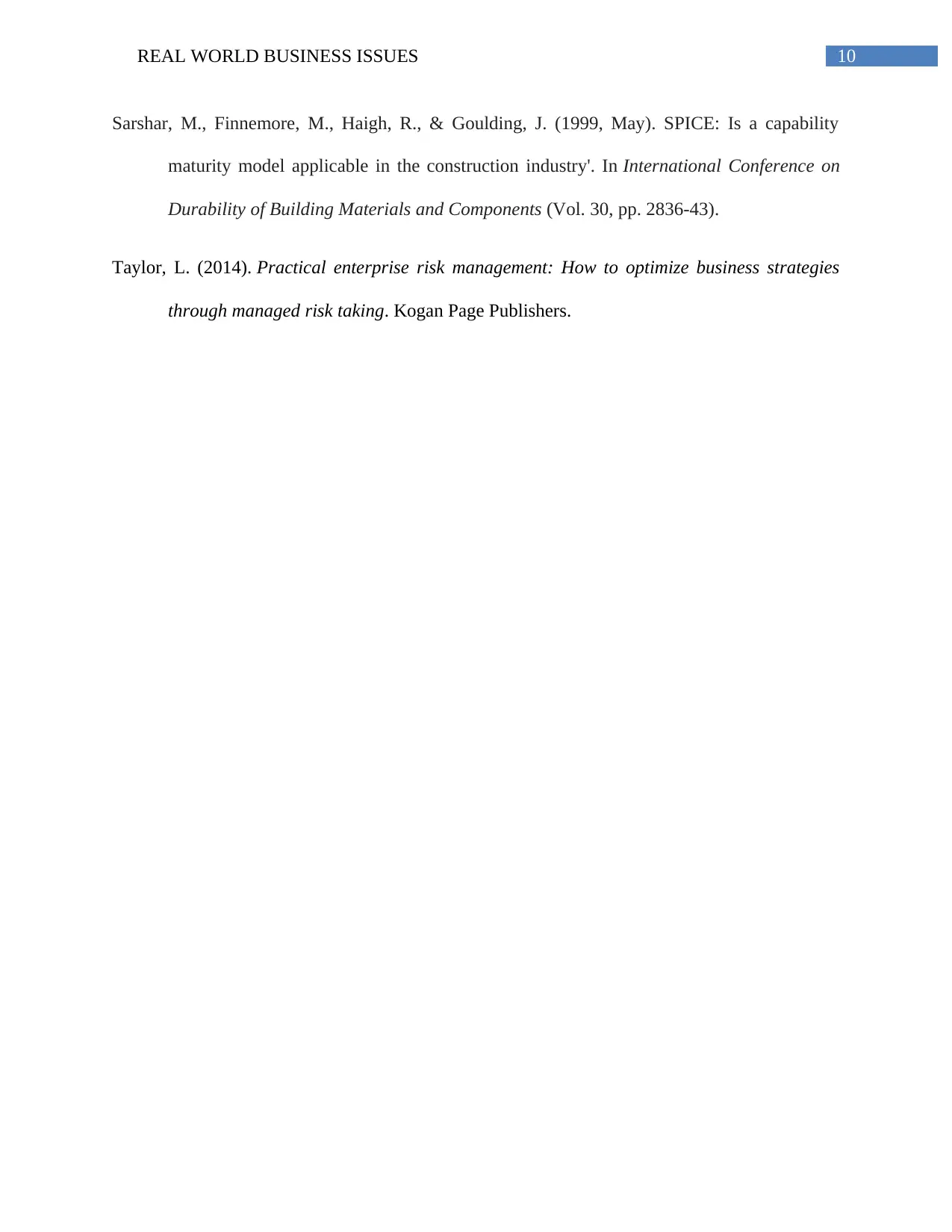
10REAL WORLD BUSINESS ISSUES
Sarshar, M., Finnemore, M., Haigh, R., & Goulding, J. (1999, May). SPICE: Is a capability
maturity model applicable in the construction industry'. In International Conference on
Durability of Building Materials and Components (Vol. 30, pp. 2836-43).
Taylor, L. (2014). Practical enterprise risk management: How to optimize business strategies
through managed risk taking. Kogan Page Publishers.
Sarshar, M., Finnemore, M., Haigh, R., & Goulding, J. (1999, May). SPICE: Is a capability
maturity model applicable in the construction industry'. In International Conference on
Durability of Building Materials and Components (Vol. 30, pp. 2836-43).
Taylor, L. (2014). Practical enterprise risk management: How to optimize business strategies
through managed risk taking. Kogan Page Publishers.
1 out of 11
Related Documents
Your All-in-One AI-Powered Toolkit for Academic Success.
+13062052269
info@desklib.com
Available 24*7 on WhatsApp / Email
![[object Object]](/_next/static/media/star-bottom.7253800d.svg)
Unlock your academic potential
Copyright © 2020–2025 A2Z Services. All Rights Reserved. Developed and managed by ZUCOL.

